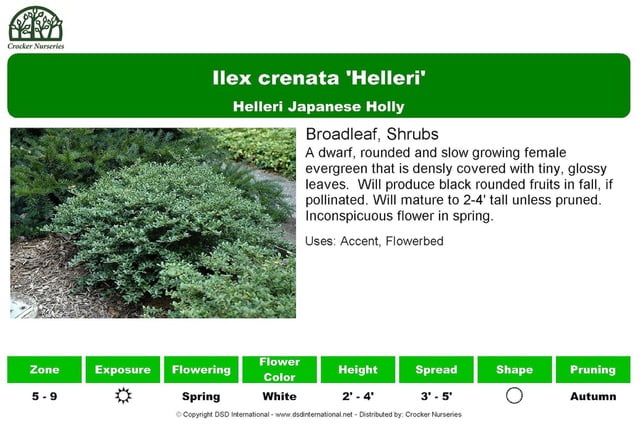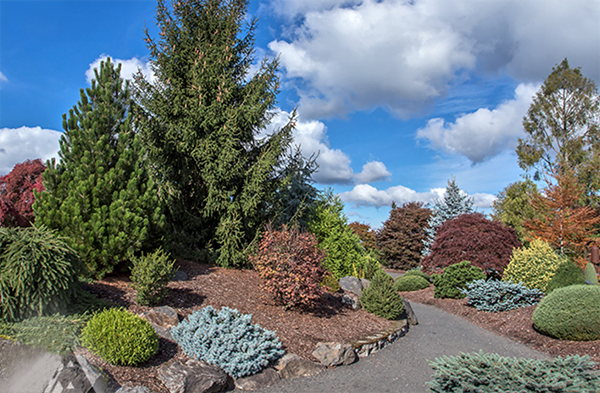
The subject we are going to go over in this lesson is spacing. How much room do you put between plants? How much room do you put between plants and structures, plants and overhead wires, plants and streets?
You are probably wondering why one lesson is devoted to just this subject. The reason for this is that more problems are created from improperly spaced trees and shrubs than any other landscaping mistake.
Here are just a few examples:
- Trees too close to overhead wires having to be hacked to death to protect the wires
- Shrubs completely overtaking a bed and covering up smaller plants below it.
- Fast growing shrubs taking over slower-growing shrubs
- Trees or shrubs getting so big, they block the sun for other plants.
- Trees growing too close to a house and potentially causing damage during storms.
- Shrubs growing too large in front of windows and blocking walkways.
If you had paid for a landscape design and any of the above problems occurred, I am sure you would not be happy. So, part of creating a successful landscape design is to know how to space the trees and shrubs in the landscape.
How do you know how far to space shrubs?
When you choose a tree or shrub, you should be provided with information about the plant in the form of signage or plant tag. One of the most important pieces of information to get when you are plant shopping is the Full Botanical Name.
For example the botanical name of Blue Hydrangea is Hydrangea macrophylla. However, most Hydrangeas you find in your local nursery are cultivars* of this species* and have a large range of characteristics including the height and width of the plant. Hydrangea macrophylla ‘ Nikko Blue’ will grow 5-6’ tall and 6-8’ wide. Compare this to Hydrangea macrophylla ‘Bailmer’ (commonly called Endless Summer) which grows only 3-4’ tall and 3-4’ wide.
If you were planning a smaller Hydrangea to go in your perennial garden and by mistake got a Nikko Blue Hydrangea, within two years you would have problems.
It is vital to know what the Botanical name is for the plant you are picking out. If you get the incorrect plant, all your planning can be wasted. At Crocker Nurseries we have always been very diligent in tagging plants with the proper names as well as having signage with the Botanical Name and Common Name and characteristics including height and width so you can make an educated decision.

Now that you know how big a shrub will get, exactly how do you plan that in your design?
One of the first things you have to decide is how you would like your garden to look? Do you a) want space between the plants even when they are fully grown or do you b) want them to spill over each other a little or c) want them to spill over a lot.
One thing to consider when making this decision is that maintenance increases from option 1 to 3. When plants are separated, very little pruning is required during the season and because there is airflow, disease is not prevalent and bugs do not spread quickly. On the other hand, if your plants are spilling over themselves, pruning will be necessary and disease and insects can spread more easily, thus, more maintenance.
When doing a design, half of your work is done when you have accurate information on the plants you will be using. Another great resource that we use is the www.missouribotanicalgarden.org Plant Finder. It has a huge Library of information about plants that grow in our zone. You can also Google a plant name and get info. Steer away from sponsored ads because the info may not be accurate. Often times Missouri Botanical will come up in a Google search.
What’s Next?
Now we draw the plants on paper. We will be going over specific plants in later lessons but let’s use this chance to practice. Let us create a bed using Hydrangea macrophylla ‘Nikko Blue’, Hydrangea macrophylla ‘Bailmer’ and Ilex crenata ‘Helleri’ as our practice plants. We will make a bed primarily of Hydrangeas of two sizes and an evergreen edge.

In this diagram the plants are drawn with three sizes: the original plant you bought, the plant in 2 years and then space for the plant to grow to full maturity. You can see how much space is needed around the original plants you purchased to allow for future growth. Given that information, here is what usually happens. When you actually plant these beds you are going to say to yourself, without fail, “This bed looks so empty!” This is completely understandable! However, it will fill in, in only a few short years. How can you handle the impatience you are feeling and the inclination to go back to the nursery and get another 1 or 2 shrubs to ‘fill in’?
Here are a few options:
- Plant annuals in the spaces- they are not permanent and will fill those gaping holes.
- Place a piece of garden statuary in one of the spaces. It is much more pleasant to view a piece of art when it does have some space around it.
- Plant up some pots and sink them down in the ground a few inches and plant with overflowing flowers. This will fill up the space.
- Enjoy the look of an individual plant. Often when plants get crowded they get misshapen. When a plant has room to grow, it will look natural and lovely. So go and admire it!
Three years down the road, you will not have room for annuals or pots or statuary AND you will not have to transplant things out of the bed- your planting will be perfect!
Here is a rule of thumb- if you see a new landscape and there is no space around the plants, you are looking at a future problem.
How to Handle Trees
Trees provide their own types of problems. It is very important to find out the mature spread of the tree. When you know what tree you want, go outside and look up and see if there are any barriers in the way of that tree reaching maturity. If you want an Acer rubrum (red maple) in your yard, the eventual spread is 40 feet. Therefore you need to mark the spot you want to plant and measure 20’ out all around in a circle and make sure the tree will not interfere with any electric or telephone lines or anything else in the way of structures. Additionally, if a tree is planted too close to the house it can damage the structure in storms. Do the same procedure: if the tree has a 25’ spread, make sure it is planted at least 12.5’ from the house.
Also, if you have a sunny yard and have designed your gardens for sun, think about what effect a large shade tree will have on your established gardens. You may be able to place it where it does not block the sun, but just be aware of it.
Shrubs in Foundation Plantings
When choosing shrubs for a foundation planting, I would recommend using the dwarf variety of every type of plant or just compact growing shrubs. You do not want to overcome your house with shrubs that cover the windows and spill out into the entrance and front walk. Use smaller growing (less than 3’) shrubs in general UNLESS you are trying to block something specific or if you have a blank wall to cover. Then you could go a little higher.
Shrub Grouping Tip
When you are planting groups of shrubs together or perennials or grasses, be aware of how fast a particular plant grows. For example, if you like dwarf conifers (needle evergreens), you could plant a nice assortment of colors and textures in a planting with some interesting rocks and maybe a few dwarf perennials. However if you stuck a forsythia in the middle, it would look silly. The conifers and perennials are all compact and slow growing and the forsythia is fast growing and wild looking.
The Power of Choice
Now that you have the tools you need to find out the size and spread of plants and determine how close to space them, you have decisions to make when you are planting in your garden. Plants can be controlled and kept smaller or shaped into interesting shapes. If you are a seasoned gardener, you can prune shrubs and trees and separate perennials and control the eventual size of a plant to a degree. However, if you are a novice, then you should follow these guidelines when planting and save yourself some headaches. Knowledge is power and knowing what you are starting with gives you the ability to make your own gardening decisions.
*Species- Plants which share similar characteristics with each other.
*Cultivar- a plant that is produced and maintained by horticulturists but does not produce true-to-seed (if you plant a seed, it will not produce the same characteristics). Cultivars are shown by being capitalized with single quotes around them.

Excellent!
Thank you for this mini course and helping us to make Cape Cod beautiful.